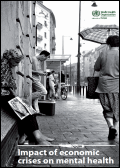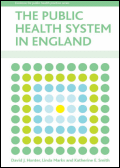LU POUR VOUS DE MAI 2011 : livres du mois - sites du mois - working papers
Tous les lu pour vous
LES LIVRES DU MOIS
Maladies chroniques et travail : au-delà des idées reçues.
Obrecht O. / dir., Hittinger - Le Gros M.C.
Paris : Editions de Santé ; Paris : Presses de Sciences Po : 2010 : 118 p.
L'employabilité est une donnée fragile dans le contexte actuel tendu du monde du travail ; tout ce qui concourt à préserver la personne en situation de travail va dans la bonne direction. Aujourd'hui, seule la reconnaissance de la qualité de travailleur handicapé paraît de nature à aider significativement le travailleur malade, alors que même l'image sociale du handicap peine encore à évoluer, suite à la loi de 2005. Au moment où la réforme des retraites va conduire à prolonger les durées d'activité et à reconsidérer les notions de pénibilité, où le vieillissement de la population active s'accélère et avec lui l'augmentation de la prévalence des maladies chroniques, où enfin l'avenir des services de santé au travail est posé, la nécessité est apparue d'amorcer une réflexion prospective sur les enjeux, les blocages et les leviers d'action potentiels susceptibles d'être mobilisés afin que maladie ne rime pas avec marginalisation au regard de l'emploi. Cette démarche a conduit la chaire Santé de Sciences Po et le Centre d'analyse des politiques publiques de santé de l'Ecole des hautes études en santé publique (EHESP) à animer un séminaire de travail de janvier à juin 2010, dont cet ouvrage constitue la synthèse des travaux (4e de couverture).
Les inégalités de santé dans les territoires français. Etat des lieux et voies de progrès.
Vigneron E.
Issy les Moulineaux : Elsevier Masson : 2011/03 : 194 p.
Les inégalités territoriales de santé (ITS) sont profondes dans la France d'aujourd'hui. Bien sûr, elles existaient déjà, mais elles s'aggravent notamment sous l'effet de la crise économique, qui frappe inégalement les territoires, et sous l'effet de la concentration de l'offre de soins dans certaines zones. Les ITS constituent une forme insidieuse et silencieuse des inégalités de santé. De nombreux habitants vivent en marge des centres et, donc, du dynamisme socio-économique et des revenus qu'il génère : zones rurales reculées, centres et banlieues déshérités...Au problème de l'accessibilité économique, se mêlent ceux de l'accessibilité géographique. Sur la base d'un constat très documenté, cet ouvrage, réalisé en partenariat avec Sanofi Aventis, offre de vraies révélations (comme ces coupes sur le taux de mortalité à Paris et en banlieue), de nombreuses études inédites mais aussi une trentaine de propositions d'actions concrètes (Résumé d'auteur).
Qu'est-ce que la justice sociale ? Reconnaissance et redistribution.
Fraser N., Ferrarese E.
Paris : Editions de la découverte : 2011 : 179 p.
La reconnaissance est aujourd'hui un concept central du débat politique. Mais dans quelle mesure peut-elle s'intégrer à une réflexion normative sur la justice sociale ? C'est à cette question que répond la philosophe américaine Nancy Fraser, qui établit une distinction entre ce qu'elle appelle une politique de reconnaissance et une politique de redistribution. La première insiste sur l'égal respect dû à tous les membres d'une société, la seconde sur une redistribution équitable des biens et des ressources. Pour l'auteure, les conflits entre ces deux orientations sont politiquement paralysants et théoriquement insatisfaisants. En affirmant qu'une démocratie radicale consiste à reconnaître le caractère multiculturel et sexué des sociétés modernes, sans figer les identités des différents groupes ni renoncer à l'engagement historique de la gauche en faveur de l'égalité économique et sociale, elle vise à la réconciliation de la gauche culturelle et de la gauche sociale. Pour cette raison, cet ouvrage de philosophie politique est, à bien des égards, un livre politique (4e e couverture).La reconnaissance est aujourd'hui un concept central du débat politique. Mais dans quelle mesure peut-elle s'intégrer à une réflexion normative sur la justice sociale ? C'est à cette question que répond la philosophe américaine Nancy Fraser, qui établit une distinction entre ce qu'elle appelle une politique de reconnaissance et une politique de redistribution. La première insiste sur l'égal respect dû à tous les membres d'une société, la seconde sur une redistribution équitable des biens et des ressources. Pour l'auteure, les conflits entre ces deux orientations sont politiquement paralysants et théoriquement insatisfaisants. En affirmant qu'une démocratie radicale consiste à reconnaître le caractère multiculturel et sexué des sociétés modernes, sans figer les identités des différents groupes ni renoncer à l'engagement historique de la gauche en faveur de l'égalité économique et sociale, elle vise à la réconciliation de la gauche culturelle et de la gauche sociale. Pour cette raison, cet ouvrage de philosophie politique est, à bien des égards, un livre politique.
Comment préserver l'accès aux médicaments : innovation pharmaceutique et santé publique.
Correa C.M. / dir., Velasquez G. / dir.
Paris : L'Harmattan : 2010 : 184 p.
D'un côté on souhaite légitimement encourager l'innovation dans le domaine pharmaceutique. D'un autre, on ne veut pas que les privilèges accordés à certains pour les encourager à innover ne permettent, en abusant de ceux-ci, de réduire l'accès aux médicaments. Y a-t-il un équilibre possible entre le soutien à l'innovation, la protection de la propriété intellectuelle et l'accès aux médicaments pour tous ? (4e de couverture.)
Médecines parallèles et cancer : une étude sociologique.
Begot A.C.
Paris : L'Harmattan : 2010 : 201 p.
Ce qui est communément désigné par "médecines parallèles" est une construction sociale qui, au regard d'une analyse socio-historique, permet de rendre compte des rapports de force au sein du champ des soins de santé. A partir de cette analyse et d'une étude de terrain menée auprès de personnes touchées par le cancer et ayant recours aux "médecines parallèles", cet ouvrage cherche à dégager les usages sociaux de ces médecines, le sens qu'elles recouvrent, et les démarches dans lesquelles elles s'inscrivent (4e de couverture).
Impact of economic crises on mental health.
L'impact des crises économique sur la santé mentale.
World Health Organization. (W.H.O.). Regional Office for Europe. Copenhagen. DNK
Copenhague : OMS Bureau Regional de l'Europe : 2011 : 23 p.
The economic crisis is expected to produce secondary mental health effects that may increase suicide and alcohol death rates. However, the mental health effects of the economic crisis can be offset by social welfare and other policy measures. For example, active labour market programmes aimed at helping people retain or regain jobs counteract the mental health effects of the economic crisis. Family support programmes contribute to counteracting the mental health effects of the crisis. Increasing alcohol prices and restricting alcohol availability reduce the harmful effects on mental health and save lives. Debt relief programmes will help to reduce the mental health effects of the economic crisis and accessible and responsive primary care services support people at risk and prevent mental health effects (4e de couverture).
Universal Health Insurance in France. How Sustainable? Essays on the French Health Care System.
La couverture maladie universelle en France est-elle viable? Essais sur le système de santé français.
Rodwin V.G.
Washington : Ambassade de France : 2011 : 228 p.
In Part I of this book, the essays focus on health care reform, in France, and speculate on how the system is likely to evolve. Opinions range from raising the policy dilemmas posed by state-led managed care (Claude Le Pen and I in Ch. 2) to presenting the system and its recent reforms as a possible model for Americans (Paul Sorum in Ch. 3) to analyzing current strains and “cleavages” that threaten to make the system implode (Jean de Kervasdoué in Ch. 4). The Part II presents the own viewof the author on the French health care system and its lessons for reformers in the United States (Ch. 5) followed by an analysis of the system by three economists (Ch. 6) from the Organization for Economic Cooperation and Development (OECD). Next are included two essays that provide an overview of the system and its historical evolution. The first (Ch. 7) is drawn from a full-length World Health Organization (WHO) Regional Office monograph on the French health system (European Observatory on Health Systems and Policies); the second (Ch. 8) is a paperwritten by the author with Simone Sandier, which demonstrates an essential characteristic of French NHI—its low prices and high levels of service provision. Although the paper dates from 1993, the analysis still holds up in 2006. Finally, this book presents a selected bibliography, in English (Part III), on the French health care system, including some important web sites for French readers who wish to pursue research on the subject (Tiré de l'introduction).
The public health system in England.
Le système de santé publique en Angleterre.
Hunter D.J., Marks L., Smith K.E.
Bristol : The Policy Press : 2010 : 192 p.
Health systems everywhere are experiencing rapid change in response to new threats to health, including from lifestyle diseases, risks of pandemic flu, and the global effects of climate change but health inequalities continue to widen. Such developments have profound implications for the future direction of public health policy and practice. The public health system in England offers a wide-ranging, provocative and accessible assessment of challenges confronting a public health system, exploring how its parameters have shifted and what the origins of dilemmas in public health practice are. The book will therefore appeal to public health professionals and students of health policy, potentially engaging them in political and social advocacy (4e de couverture).
LES SITES DU MOIS DE MAI
Portail Epidémiologie France
epidemiologie-france.fr
Presentation
Ce site est le fruit de la collaboration entre l'Inserm – Institut thématique Santé Publique (ISP), la Direction Générale de la Compétitivité de l'Industrie et des Services (DGCIS) du Ministère de l'Economie et le Leem (Les Entreprises du Médicament). Les bases de données en santé référencées sont celles associées aux activités de recherche du secteur public et du secteur privé, les principales enquêtes « santé » du champ de la statistique publique, les dispositifs de recueil permanent utiles à la fois à la recherche et à la surveillance sanitaire comme les registres de morbidité et enfin, les grandes bases médico-administratives constituées pour aider à la gestion des dépenses de l'assurance-maladie et des structures de soins (SNIIRAM, PMSI,…).
Ce nouvel outil Internet propose un catalogue en ligne les principales bases de données en santé de source française qui peuvent être utiles au développement de la recherche et de l'expertise en santé publique. Chaque base de données répertoriée dans le catalogue est décrite selon ses caractéristiques essentielles : objectifs, thématiques, populations couvertes, nature des informations recueillies, conditions d'accès, responsable,…Le catalogue est enrichi directement en ligne par les différents contributeurs grâce à un espace de travail sécurisé. Un glossaire présent sur le site propose des éléments de définition et d'aide au remplissage du formulaire
Elfe Etude Longitudinale depuis l'Enfance
www.elfe.ined.fr
Presentation
Ce site est dédié à la première étude longitudinale française consacrée au devenir de 20000 enfants sur 20 ans. Elle vise à répondre à de nombreuses questions concernant la santé, le développement l'éducation, la socialisation des enfants de tous milieux sociaux. Elle est pilotée par l'Institut national d'études démographiques (Ined), l'Institut national de la santé et de la recherche médicale (Inserm), en partenariat avec l'Etablissement français du sang (EFS). Le site présente les objectifs de l'étude, les conditions de participation et les grandes étapes du suivi. Il met également en avant les orientations majeures et les grandes thématiques de recherche qui vont être explorées.
Epigramme
ines.csd-studies.com/binetude/Etude9/crt_cohorteclt.aspx
Presentation
L'Iresp, en collaboration avec l'Institut Santé Publique de l'Inserm, a réalisé une base de données appelée Epigramme, recensant toutes les cohortes ayant une dimension santé, qu'elles soient terminées, en cours ou en préparation. L'objectif de cette base est de rassembler pour la première fois des données issues de différentes institutions afin d'avoir un panorama complet des études de cohortes portant sur la santé. La création de cette base rejoint une demande de la Direction Générale de la Recherche et de l'Innovation, car elle est un pré-requis pour mettre en place une politique de financement des cohortes dans les années qui viennent. Elle permettra par ailleurs aux chercheurs d'avoir connaissance de l'ensemble des cohortes réalisées en France. La recherche des cohortes peut se faire selon leurs caractéristiques administratives (acronyme de la cohorte, nom du responsable, financeur(s) ou selon leurs thématiques (thème principal, type de population observée, évènement de santé observé..): Il est également possible de télécharger les résultats de la recherche sous format excel.
VU DE L'ETRANGER : QUELQUES WORKING PAPERS ANALYSES
Assurance maladie
Selection on Moral Hazard in Health Insurance. 

Sélection concernant le hasard moral en assurance maladie.
Einav L., Finkelstein A., Ryan S.P.
Cambridge : NBER : 2011/03 : 68 p.
In this paper we explore the possibility that individuals may select insurance coverage in part based on their anticipated behavioral response to the insurance contract. Such selection on moral hazard can have important implications for attempts to combat either selection or moral hazard. We explore these issues using individual-level panel data from a single firm, which contain information about health insurance options, choices, and subsequent claims. To identify the behavioral response to health insurance coverage and the heterogeneity in it, we take advantage of a change in the health insurance options offered to some, but not all of the firm's employees. We begin with descriptive evidence that is suggestive of both heterogeneous moral hazard as well as selection on it, with individuals who select more coverage also appearing to exhibit greater behavioral response to that coverage. To formalize this analysis and explore its implications, we develop and estimate a model of plan choice and medical utilization. The results from the modeling exercise echo the descriptive evidence, and allow for further explorations of the interaction between selection and moral hazard. For example, one implication of our estimates is that abstracting from selection on moral hazard could lead one to substantially over-estimate the spending reduction associated with introducing a high deductible health insurance option.
Economie de la santé
Assessing the Effectiveness of Health Care Cost Containment Measures. 

Santé et bien-être en temps de crise.
Ziebarth N.R.
Bonn : IZA : 2011/03 : 32 p.
Using SOEP panel data and difference-in-differences methods, this study is the first to empirically evaluate the effectiveness of four different health care cost containment measures within an integrated framework. The four measures investigated were introduced in Germany in 1997 to reduce moral hazard and public health expenditures in the market for convalescent care. Doubling the daily copayments was clearly the most effective cost containment measure, resulting in a reduction in demand of about 20 percent. Indirect measures such as allowing employers to cut statutory sick pay or paid vacation during health spa stays did not significantly reduce demand.
Health and Well-Being in the Crisis. 

Santé et bien-être en temps de crise.
Askitas N., Zimmermann K.F.
Bonn : IZA : 2011/03 : 28 p.
The internet has become an important data source for the Social Sciences because these data are available without lags, can be regarded as involuntary surveys and hence have no observer effect, can be geo-labeled, are available for countries across the globe and can be viewed in continuous time scales from the micro to the macro level. The paper uses internet search data to document how the great economic crisis has affected people's well-being and health studying the US, Germany and a cross section of the G8 countries. We investigate two types of searches which capture self-diagnosis and treatment respectively: those that contain the words 'symptoms' and 'side effects'. Significant spikes for both types of searches in all three areas (US, Germany and the G8) are found, which are coincident with the crisis and its contagion timeline. An array of due diligence checks are performed and a number of alternative hypotheses are excluded to confirm that the search spikes imply an increase in malaise.
Hôpital
Do Waiting Times Matter in Primary Care? GP Visits and List Sizes in England. 

Les temps d'attente ont ils de l'importance dans les soins primaires ? Les visites chez le médecins généraliste et la longueur des listes d'attente en Angleterre.
Polisson M.
Oxford: University of Oxford : 2011 : 43 p.
This paper is largely motivated by the empirical observation that GP visits per person under the NHS have increased in England since the mid-1970s, while list sizes have decreased over the same period A hypothesis consistent with this observation is that larger list sizes are associated with longer waiting times, which reduce the demand for GP visits. Using a time series of repeated cross sections from 1972 to 2004, we construct a pseudopanel of synthetic individuals and find very little evidence that list sizes affect visit frequencies. While there are mild associations consistent with the waiting-time hypothesis among working-age women, there are none for men or the elderly, and no associations are robust to the cohort analysis. The demand for GP visits is most likely driven by health status, and for women, childbirth.
The impacts of health care reforms on the efficiency of the Turkish public hospitals: Provincial markets. 

L'impact des réformes de santé sur l'efficience des hôpitaux turcs : le cas des marchés en province.
Sulku S.N.
Munich : Munich Personal RepEc Archive : 2011 : 20 p.
Turkey has implemented major health care reforms to improve the efficiency of the health care system since 2003. The objective of this study is to investigate the impact of these reforms, especially the performance-based payment system (P4P), on the efficiency of public hospitals. We employ the Data Envelopment Approach and the Malmquist index to comparatively examine before and after the reform years, 2001 and 2006 respectively. Our analyses compare the performances of public hospitals served in provincial markets. Inputs of number of beds, number of primary care physician, and number of specialists, and how they are used to produce outputs of inpatient discharges, outpatient visits, surgical operations are investigated. Indeed, as the quality indicators dead rate, hospital bed occupation rate and average length of stay are considered. We found that the P4P was successful in boosting productivity due to advancements in technology and technical efficiency. It is seen that the average technical efficiency gains took place because of the significantly improved scale efficiencies, but the average pure technical efficiency did not improve. The lower pure technical efficiencies compared to scale efficiencies affirms the lack adaptation of the hospital management to the renewed system. Additionally, our analysis indicates that in the socio-economically disadvantaged provinces productivity gains have not been achieved. Lastly, it is seen that the hospital quality indicators have not improved in the short run. In the international literature, P4P has been examined extensively for the developed countries. However there are a limited number of studies on developing countries. As it has been noted in the OECD health system review of Turkey: “Turkey is closing the performance gap with other OECD countries and, on a number of measures including overall costs, performs well relative to other comparable upper middle-income countries. Indeed, there may be much that other countries can learn from the recent health reforms in Turkey, especially in the use of performance-related pay to raise staff productivity”. Thus, our study would contribute to the existing literature with a comprehensive analysis of the health system efficiency in Turkey.
Testing for the Role of Prejudice in Emergency Departments Using Bounceback Rates. 

Test utilisant les taux de retour pour l'évaluation des préjugés dans les services d'urgence.
Anwar S., Fang H.
Cambridge : NBER : 2011/03 : 38 p.
We propose and empirically implement a test for the presence of racial prejudice among emergency department (ED) physicians based on the bounceback rates of the patients who were discharged after receiving diagnostic tests during their initial ED visits. A bounceback is defined as a return to the ED within 72 hours of being initially discharged. Based on a plausible model of physician behavior, we show that differential bounceback rates across patients of different racial groups who are discharged after receiving diagnostic tests from their ED visits are informative of the racial prejudice of the physicians. Applying the test to administrative data of ED visits from California and New Jersey, we do not find evidence of prejudice against black and Hispanic patients. Our finding suggests that, at least in the emergency department setting, taste based discrimination does not play an important role in the racial disparities in health care.
Inégalités de santé
Comparaison internationale des inégalités sociales de santé en Europe : Cas du Luxembourg avec 23 autres pays. 

Tchicaya A., Demarest S., Lorentz N.
Differdange : CEPS : 2011/02 : 18 p.
Ce texte porte sur la mesure et la comparaison des inégalités de santé liées au niveau d'éducation au Luxembourg et dans 23 autres pays européens. Les données proviennent des enquêtes/EU-SILC réalisées sous l'égide d'Eurostat en 2007 dans l'Union Européenne, l'Islande et la Norvège. Elles concernent les personnes âgées de 16 ans et plus dans les ménages privés. Les principales procédures mathématiques utilisées sont la modélisation linéaire généralisée et les techniques de standardisation par âge et par sexe afin de faciliter les comparaisons dans le temps et dans l'espace. Les résultats montrent l'existence d'inégalités sociales de santé, tant chez les hommes que chez les femmes dans tous les pays. Le Luxembourg occupe une position intermédiaire par rapport à ses pays voisins, une bonne position par rapport aux pays scandinaves et une moins bonne position par rapport aux pays de l'ancienne Europe de l'Est. Globalement, les inégalités sociales de santé paraissent plus élevées dans des pays où les taux de prévalence d'une moins bonne santé sont parmi les plus faibles.
Discrimination makes me Sick ! Establishing a relationship between discrimination and health. 

La discrimination me rend malade ! Etablissement d'un lien entre discrimination et santé.
Lordan G., Johnston D.
Queensland : University of Queensland : 2011 : 33 p.
The attitudes of the general British population towards Muslims changed post 2001, and this change led to a significant increase in Anti-Muslim discrimination. We use this exogenous attitude change to estimate the causal impact of increased discrimination on a range of objective and subjective health outcomes. The difference-in-differences estimates indicate that discrimination worsens blood pressure, cholesterol, BMI, self-assessed general health, and some dimensions of mental health. Thus, discrimination is a potentially important determinant of the large racial and ethnic health gaps observed in many countries. We also investigate the pathways through which discrimination impacts upon health, and find that discrimination has a negative effect on employment, perceived social support, and health-producing behaviours. Crucially, our results hold for different control groups and model specifications.
Médicaments
A Primer on the Economics of Prescription Pharmaceutical Pricing in Health Insurance Markets. 

Rudiments sur l'économie de la fixation des prix des médicaments sur le marché de l'assurance maladie.
Berndt E.R., McGuire T.G., Newhouse J.P.
Cambridge : NBER : 2011/03 : 39 p.
The pricing of medical products and services in the U.S. is notoriously complex. In health care, supply prices (those received by the manufacturer) are distinct from demand prices (those paid by the patient) due to health insurance. The insurer, in designing the benefit, decides what prices patients pay out-of-pocket for drugs and other products. In this primer we characterize cost and supply conditions in markets for generic and branded drugs, and apply basic tools of microeconomics to describe how an insurer, acting on behalf of its enrollees, would set demand prices for drugs. Importantly, we show how the market structure on the supply side, characterized alternatively by monopoly (unique brands), Bertrand differentiated product markets (therapeutic competition), and competition (generics), influences the insurer's choices about demand prices. This perspective sheds light on the choice of coinsurance versus copayments, the structure of tiered formularies, and developments in the retail market.
Pricing of Drugs with Heterogeneous Health Insurance Coverage. 

Fixation des prix des médicaments dans un contexte de couverture d'assurance maladie hétérogène.
Missios P., Ferrara I.
Toronto : Ryerson University : 2010/10 : 39 p.
In this paper, we examine the role of insurance coverage in explaining the generic competition paradox in a two-stage game involving a single producer of brand-name drugs and n quantity-competing producers of generic drugs. Independently of brand loyalty, which some studies rely upon to explain the paradox, we show that heterogeneity in insurance coverage may result in higher prices of brand-name drugs following generic entry. With market segmentation based on insurance coverage present in both the pre- and post-entry stages, the paradox can arise when the two types of drugs are highly substitutable and the market is quite profitable but does not have to arise when the two types of drugs are highly differentiated. However, with market segmentation occuring only after generic entry, the paradox can arise when the two types of drugs are weakly substituables, provided, however, that the industry is not very profitable. In both cases, that is, when market segmentation is present in the pre-entry stage and when it is not, the paradox becomes more likely to arise as the market expands and/or insurance companies decrease deductables applied on the purchase of generic drugs.
Soins de santé primaires
Physician Density in a Two-Tiered Health Care System. 

Densité médicale dans un système de santé à deux étages.
Gachter M., Schwazer P., Theurl E.
Salzburg : University of Salzburg : 2011 : 20 p.
We investigate the density of private physicians in a two-tiered health care system, i.e., one with co-existing public and private health care providers. In particular, we analyze how the densities of private and public suppliers of outpatient health care (general practitioners and specialists) are related to each other. Using a panel of 121 Austrian districts between 2002 and 2008, we find that the density of private specialists is positively associated with the density of private general practitioners, but negatively related to the density of public general practitioners. We also observe a negative relationship between the densities of private and public general practitioners and the ones of private and public specialists, indicating competitive forces between the private and the public sector of the outpatient health care provision in Austria.
Physician Response to Pay-for-Performance: Evidence from a Natural Experiment. 

La réponse du médecin à la rémunération à la performance : résultats d'une expérimentation naturelle.
Li J., Hurley J., Decicca P., Buckley G.
NBER Working Paper Series ; n° 16909
Explicit financial incentives, especially pay-for-performance (P4P) incentives, have been extensively employed in recent years by health plans and governments in an attempt to improve the quality of health care services. This study exploits a natural experiment in the province of Ontario, Canada to identify empirically the impact of pay-for-performance (P4P) incentives on the provision of targeted primary care services, and whether physicians' responses differ by age, practice size and baseline compliance level. We use an administrative data source which covers the full population of the province of Ontario and nearly all the services provided by practicing primary care physicians in Ontario. With an individual-level data set of physicians, we employ a difference-in-differences approach that controls for both “selection on observables” and “selection on unobservables” that may cause estimation bias in the identification. We also implemented a set of robustness checks to control for confounding from the other contemporary interventions of the primary care reform in Ontario. The results indicate that, while all responses are of modest size, physicians responded to some of the financial ncentives but not the others. The differential responses appear related to the cost of responding and the strength of the evidence linking a service with quality. Overall, the results provide a cautionary message regarding the effectiveness of pay-for-performance schemes for increasing quality of care.
Applying logistic regression analysis to identify patient's satisfaction predictors with general practitioner assistance: evidence from four Italian regions. 

Appliquer une régression logistique pour identifier les facteurs prédictifs de la satisfaction des patients à l'égard de l'aide que leur apporte leur médecin généraliste : résultats dans quatre régions italiennes.
Panero C., Murante A.M., Perucca G.
Pise : Scuola Superiore Sant'Anna di Pisa. : 2010 : 24 p.
In the last years the interest for patient experience with health care services largely increased. Several surveys have been conducted in order to observe if health care systems answer to the overall patient needs. In 2000 World Health Organization challenged modern health care providers to ensure responsiveness to patients, i.e. to deliver also non-health assistance (respect for dignity, confidentiality, prompt attention, quality of amenities, access to social support networks, choice of provider, etc.). Poor evidence is available in Italy about connections between perceived quality and the capability of the healthcare system to respond to patients' needs. This work aims at investigating patient experience with General Practitioner (GP) assistance and at measuring the impact of personal and organizational characteristics on overall satisfaction and on willingness to recommend. In 2009 a sample survey was conducted in f our regions of Italy (Tuscany, Piedmont, Umbria, and Liguria). About 15.000 citizens answered to a large questionnaire related to Primary Care services, including a section dedicated to General Practitioner (GP) assistance. A logistic regression analysis was applied to analyze which are the predictors of overall satisfaction with GP, focusing mainly on variables related to patient's expectations, continuity of care and organizational aspects (e.g. scheduled access, waiting time, health case history, etc.) and if there are differences across the four Italian Regions. Econometric analysis has been carried out through both ordered logistic regression and generalised ordered logit models. The inhabitants of the four Italian Regions refer a nice experience with GP assistance: more than 85% of them judged excellent or good the overall service. Generally, in some regions patient expectations affect more the willingness to recommend GP to friends or family members than the overall judgement on service. Besides, the findings provide convincing evidence that GP is a nodal point in the continuity of care process .
Systèmes de santé
Market Inefficiency, Insurance Mandate and Welfare: U.S. Health Care Reform 2010. 

Inefficacité du marché, assurance et welfare : la réforme du système de santé américain 2010.
Jung J., Tran C.
Sydney : School of Business : 2011 : 41 p.
In this paper we develop a stochastic dynamic general equilibrium overlapping generations (OLG) model with endogenous health capital to study the macroeconomic effects of the Affordable Care Act of March 2010 also known as the Obama health care reform. We find that the insurance mandate enforced with fines and premium subsidies successfully reduces adverse selection in private health insurance markets and subsequently leads to almost universal coverage of the working age population. On other hand, spending on health care services increases by almost 6 percent due to moral hazard of the newly insured. Notably, this increase in health spending is partly financed by the larger pool of insured individuals and by government spending. In order to finance the subsidies the government needs to either introduce a 2.7 percent payroll tax on individuals with incomes over $200,000, increase the consumption tax rate by about 1.1 per cent, or cut government spending about 1 percent of GDP. A stable outcome across all simulated policies is that the reform triggers increases in health capital, decreases in labor supply, and decreases in the capital stock due to crowding out effects and tax distortions. As a consequence steady state output decreases by up to 2 percent. Overall, we find that the reform is socially beneficial as welfare gains are observed for most generations along the transition path to the new long run equilibrium.
Travail et santé
Chronic diseases and labor market outcomes in Egypt. 

Maladies chroniques et performance sur le marché du travail en Egypte.
Rocco L., Suhrcke M., Fumagali E.
New York : World Bank : 2011/02 : 31 p.
By causing a sizeable reduction in employment 6 percent and labor supply 19 percent, chronic diseases are responsible for a major efficiency loss in the Egyptian economy. Furthermore the impact of chronic diseases on the labor market is not uniformly distributed. The older and the less educated suffer a larger drop in the probability of being employed and in their supply of working hours. The authors estimate the reduced form equations of individual employment status, labor supply and the usual wage equation. They control for unobserved ability and individual preferences by means of a within-siblings estimator. Measurement errors in our self-reported health variable have been accounted for.
Vieillissement
Reporting Heterogeneity in Self-Assessed Health Among Elderly Europeans : The Impact of Mental and Physical Health Status. 

Rendre compte de l'hétérogénéité dans l'auto-évaluation par les européens âgées de leur état de santé. L'impact de l'état de santé physique et mental.
Pfarr C., Schmid A., Schneider U.
Rochester : Social Science Electronic Publishing : 2011/01 : 30 p.
Self-assessed health (SAH) is a frequently used measure of individuals' health status. It is also prone to reporting heterogeneity. To control for reporting heterogeneity valid measures of the objective health status are needed. The topic becomes even more complex for cross-country comparisons, as many key variables tend to vary strongly across countries, influenced by cultural and institutional differences. This study aims at exploring the key drivers for reporting heterogeneity in SAH in an international context. To this end, country specific effects are accounted for and the objective health measure is concretized, separating out effects of mental and physical health conditions. We use panel data from the Survey of Health, Aging and Retirement in Europe (SHARE) which provides a rich dataset on the elderly European population. To obtain distinct indicators for physical and mental health conditions two indices were constructed. Finally, to identify potential reporting heterogeneity in SAH a generalized ordered probit model is estimated. We find evidence that health behaviour as well as health care utilization, mental and physical health condition as well as country characteristics affect reporting behaviour. We conclude that observed and unobserved heterogeneity play an important role when analysing SAH and have to be taken into account.








